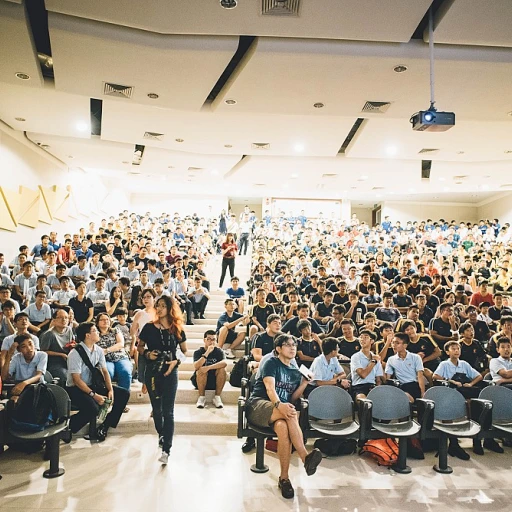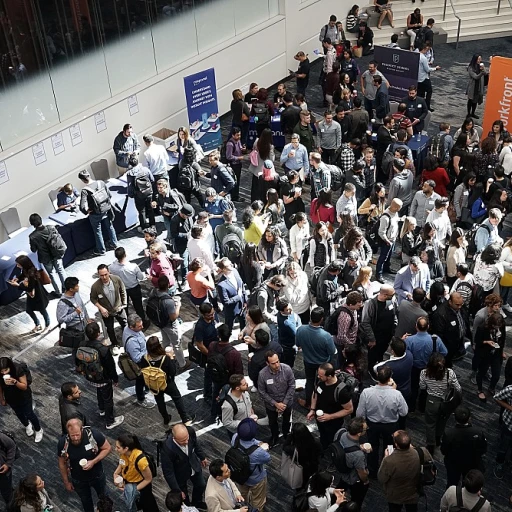
The Evolving Role of the Chief Human Resources Officer
Redefining the CHRO Role in Contemporary Organizations
The role of the Chief Human Resources Officer (CHRO) is undergoing significant transformation, driven by dynamic shifts in global business landscapes. Today's CHRO is no longer just a custodian of employment policies and procedures but an essential player in shaping business success through effective talent strategy and management. As thought leaders in human resources, these professionals are tasked with aligning strategic goals with workforce development, ensuring a future-ready organization. As we delve deeper into the future of HR leadership, particularly insights gathered from the SHRM Talent Conference, it's clear that the CHRO's role is becoming increasingly multifaceted. These leaders must embrace new responsibilities such as fostering a resilient workplace culture and developing comprehensive diversity and inclusion strategies. The imperative of navigating advancements, both in technology and intelligence systems, means that CHROs are at the forefront of integrating artificial intelligence and digital tools into daily operations and talent management processes. This intersection of technology and talent is critical for organizations looking to retain top talent and foster internal mobility. Furthermore, understanding the evolving needs of today’s workforce is paramount. As businesses anticipate shifts in future work dynamics, the focus is directed towards enhanced skills development and preparing employees for emerging roles. Consequently, CHROs must champion a culture of continuous learning and adaptation to stay ahead in the competitive global market. In summary, the modern CHRO acts as a vice president of talent, orchestrating efforts that drive organizational growth and enhance employee experience. By fostering an environment conducive to innovation and cultural intelligence, CHROs are pivotal in ensuring their organizations not only survive but thrive in the ever-evolving business arena.Key Insights from SHRM Talent 2025
Insights from Industry Leaders
At the SHRM Talent 2025 conference, industry leaders gathered to discuss the evolving landscape of human resources and the pivotal role of the Chief Human Resources Officer (CHRO) in shaping the future of work. The sessions highlighted the necessity for CHROs to adapt to the rapid changes in talent management and workforce development. As organizations strive to remain competitive, the insights shared by these thought leaders are invaluable for those looking to enhance their business success.
Embracing Technological Advancements
One of the key takeaways from the conference was the emphasis on leveraging technology to improve talent acquisition and management. With the rise of artificial intelligence and other technological tools, CHROs are now equipped to make data-driven decisions that enhance the employee experience and workplace culture. This shift not only aids in hiring top talent but also in retaining them by fostering a future-ready workforce.
Strategic Talent Management
Another significant insight was the importance of strategic talent management. As businesses become more global, the need for a diverse and inclusive workforce becomes paramount. CHROs are tasked with developing strategies that promote internal mobility and skills development, ensuring that their organizations are equipped to handle future challenges. This focus on diversity and inclusion is not just a moral imperative but a business necessity.
Preparing for Future Challenges
The sessions also underscored the importance of preparing for future challenges by building a resilient workforce. This involves not only focusing on current skills but also anticipating future skills that will be required. Aspiring CHROs must be proactive in their approach to workforce development, ensuring that their organizations are not only prepared for today but also for the challenges of tomorrow.
For more insights on the dynamics of supply and demand in HR leadership, you can explore this resource.
Navigating Technological Advancements in HR
Tackling Technological Transformation in HR
The landscape of Human Resources is in the midst of a technological revolution, reshaping how HR leaders and their teams engage with talent and strategize for the future. As these technological advancements accelerate, staying abreast of changes is vital for achieving business success. Integrating technology in HR practices not only streamlines management processes but also enhances the overall employee experience. Top talent today gravitates towards organizations that can offer a seamless blend of human touch and digital efficiency. This prudent use of technology aids in talent management, allowing HR professionals to focus on more strategic initiatives. Key to this transformation is the adoption and integration of artificial intelligence (AI). AI's ability to analyze vast amounts of data enables organizations to predict hiring needs, assess employee sentiments, and forecast future talent shortages. This capability ensures that CHROs are better equipped to make informed workforce decisions and adapt to changing workplace culture dynamics. Digital platforms are equally impactful in shaping the future work environment. They offer opportunities for skills development that are necessary for internal mobility and retaining top talent. This transformation necessitates a shift in focus towards continuous learning and development longer-term strategies to ensure that organizations remain future-ready. Industry leaders at the SHRM Talent have emphasized that embracing technological change is no longer optional—it's a business imperative. These thought leaders advocate for a balanced approach, where human creativity is supported by technological prowess, ensuring robust talent acquisition strategies and nurturing a resilient workforce ready to tackle future uncertainties. For those keen on delving deeper into these technological trends and their intersection with HR practices, understanding the dynamics of digital marketing can provide further insights into successfully navigating this new frontier. More information on this topic can be found here.Building a Resilient Workforce
Fortifying the Foundation: Creating a Strong, Resilient Workforce
Building a resilient workforce is imperative for organizations aiming to thrive in today’s rapidly evolving business landscape. As human resources leaders anticipate future shifts, their focus remains steadfast on fostering organizational resilience. This commitment is reflected in their efforts to integrate innovative strategies designed to withstand market volatility and sustaining long-term growth. Organizations across the globe are increasingly prioritizing talent management as a key component of resilience. Developing robust systems for talent acquisition and retention ensures businesses remain competitive even in fluctuating economic times. Indeed, the ability to retain top talent is central to achieving business success and is a primary objective for chief human resources officers today. An essential element of resilience revolves around adapting to change. Industry leaders recognize the necessity of agile workplace cultures, where adaptability and preparedness for change are deeply ingrained in the organizational ethos. This adaptability extends to investing in internal mobility, encouraging employees to take on new roles and responsibilities that align with evolving business needs and thus enhancing workforce stability. Moreover, HR leaders are leveraging technological advancements in human management to bolster their workforce’s resilience. Utilizing tools like artificial intelligence allows for enhanced skills development, which is crucial for preparing a future-ready workforce. By providing employees with the opportunities to upskill and reskill, organizations are better equipped to navigate future work challenges and maintain robust talent strategies. Additionally, embedding a culture of continuous learning within the organization underpins workforce resilience. Encouraging employee development not only improves individual skills but also reinforces the collective strength of the organization. A culture that values skills development ensures that employees are always prepared to meet new challenges head-on. The underlying theme connecting all these components is support from top-level leaders. Vice presidents and other executives must champion initiatives that prioritize resilience and employee experience, ensuring alignment with broader strategic objectives. As organizations endeavor to shape their future, the role of the chief human resources officer in cultivating a resilient workforce remains pivotal.Diversity and Inclusion: A Priority for CHROs
Diversity and Inclusion: A Core Focus
In today's rapidly evolving business landscape, creating a diverse and inclusive workplace is more than just a compliance requirement; it is a strategic imperative for the Chief Human Resources Officer (CHRO). It drives innovation, enhances the employee experience, and contributes to business success by attracting top talent and fostering a culture that encourages excellence and creativity. Enhancing Workplace Culture Organizations are increasingly aware that a strong commitment to diversity and inclusion significantly enriches their workplace culture. By promoting an inclusive environment where everyone, regardless of their background, feels valued and respected, businesses can improve employee engagement and retention. This not only aids in development longer-term relationships but also aligns with the strategic goals of workforce sustainability and growth. Driving Global Business Success For industry leaders, integrating diversity and inclusion strategies into their talent management practices is essential for shaping future global success. In the context of SHRM Talent 2025, sessions highlighted how organizations that prioritize these values can drive exceptional business outcomes. A diverse team offers a broader range of perspectives and solutions, which can be particularly advantageous in today’s global market. Adapting to Future Work Dynamics The future work dynamics require CHROs to be proactive in understanding and addressing the complexities of fostering inclusivity within their organizations. This includes curating talent strategies that promote internal mobility and developing a work environment where every individual has equal opportunities for advancement and skills development. By embedding diversity and inclusion into their core operations, human resources leaders set the groundwork for a resilient workforce that is future-ready. This incorporates promoting a culture where artificial intelligence and other technological tools are utilized effectively to mitigate biases and enhance workforce equality. As organizations continue to navigate the future of work, diversity and inclusion will remain a priority for CHROs, reinforcing their role as pivotal drivers of positive workplace culture and business transformation. To learn more about these dynamic HR strategies, consider exploring the insights shared by various thought leaders and experts during the session at SHRM Talent 2025.Future Skills for Aspiring CHROs
Essential Skills for Emerging HR Leaders
Aspiring Chief Human Resources Officers (CHROs) must equip themselves with a diverse set of skills to navigate the complex and ever-evolving landscape of HR leadership. As we look toward the future, several key competencies are emerging as essential for those aiming to lead in this dynamic field.- Technological Acumen: With the rise of artificial intelligence and other technological advancements, having a strong understanding of digital tools and platforms is crucial. Future HR leaders must become adept at integrating technology into their talent management strategies to enhance the employee experience and streamline operations.
- Strategic Talent Management: Organizations today require a strategic approach to talent acquisition, development, and retention. Aspiring CHROs should focus on building skills in talent strategy and workforce planning to identify and nurture top talent effectively.
- Global Business Perspective: As businesses operate in an increasingly interconnected world, HR leaders need to possess a global mindset. Understanding cultural diversity and navigating the complexities of international work environments are vital for fostering a resilient and inclusive workplace culture.
- Leadership Development: The future of work demands leaders who can build and lead resilient teams. Developing leadership within the organization not only strengthens internal mobility but also prepares the workforce for future challenges. Future CHROs should prioritize leadership skills development to ensure long-term business success.
- Data-Driven Decision Making: The ability to interpret and leverage data has become a key competency for HR leaders. Utilizing data-driven insights can significantly impact business outcomes, allowing leaders to make informed decisions concerning talent-related initiatives.












